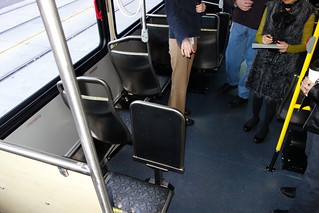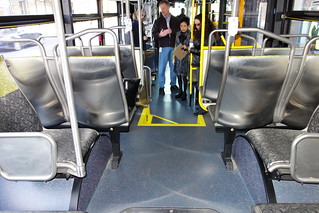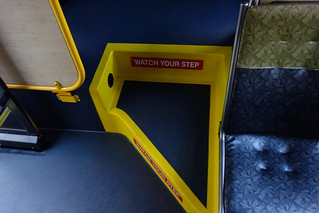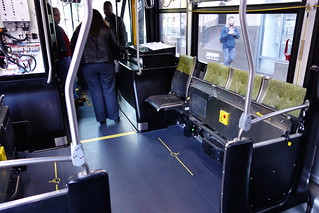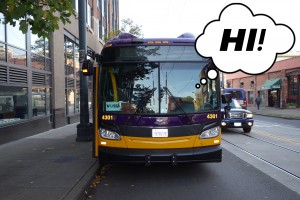 On Friday, November 7th, King County Metro opened up for public viewing the prototype of the forthcoming King County Metro 40′ Electric Trolley Buses (ETBs).
On Friday, November 7th, King County Metro opened up for public viewing the prototype of the forthcoming King County Metro 40′ Electric Trolley Buses (ETBs).
Manufactured by New Flyer, the new Xcelsior™ XT40 (and XT60) feature many design similarities with the existing fleet of RapidRide buses and the new 35′ and 40′ hybrid buses that Metro is currently bringing into service (all of which are produced by New Flyer).
This bus is part of a $164 million contract that was negotiated with New Flyer for 141 new 40′ and 60′ ETBs to replace the entire existing fleet of 155 ETBs. $138 million, or about 75% of the cost, is being provided by Federal grants and clean energy subsidies. Furthermore, the overall cost has been further reduced due to San Francisco combining their order with ours. The average cost for these new buses are $900,000 for a 40′ ETB and $1,200,000 for a 60′ ETB. In comparison, the equivalent hybrid buses are approximately $650,000 and $1,000,000 each. The order for the new fleet was determined when it seemed that service cuts were unavoidable. Thanks to the recent Seattle transit initiative passing, however, the additional service requirements may require the purchase of additional vehicles to support the expanded service within the city of Seattle.
The new ETBs feature many improvements over our existing fleet. They use 20-30% less energy to operate, and thanks to regenerative braking, they will actually provide power to the system when braking. Much to the relief of passengers, these buses are 70% low-floor (like our existing fleet) and for the first time will have air conditioning. The seats on these new buses are two-toned (yellow and gray) versions of the existing RapidRide style seats.
The 40′ ETBs feature a number of changes from both the existing fleet of ETBs as well as their related 35′ and 40′ hybrid fleets. Additional space has been created near the rear door by removing twi seats on the left-side of the bus. This creates, in effect, two single-seat rows. Furthermore, the seat layout in the rear, raised passenger section has been redesigned as well. There is now only one seat on each side over the rear wheel well facing the center aisle. In addition, there is an extra forward-facing row of seats directly in front of the rear seat row. There are actually more seats now in the rear section of the bus than the front.
The steps from the rear door up to the raised rear-section of the bus have also been changed from our existing low-floor buses to a more European style featuring angled steps.
There are two wheelchair positions in the front of the bus featuring new restraint systems that can be used by the public without assistance if they so choose (with some training). Directly behind the driver’s cab, there will be a space without a seat. This is to provide access to the electrical cabinet located there and is unavoidable.
The bus features LED lighting inside the passenger compartment, and the bus features LED low-beam headlights. There are at least three internal cameras and five external cameras that feed into the Bus Data Recorder in case of accidents or incidents.
Unlike our current fleet, these new buses have the ability to travel up to 10 miles off of the overhead electrical wires. This is possible due to the use of Li-ion (Lithium Ion) batteries. The operator is able to retract the trolley poles at the push of a button to go around obstacles as well as make any impromptu reroutes when needed. In addition, the trolley poles are designed to automatically retract and stow themselves in cases where the bus dewires. This will hopefully help further minimize delays.
The “Next Stop” display signs are being combined with the “Stop Requested” light on these buses. When a stop has been requested by a passenger, the display will alternate between the Next Stop information and “Stop Requested.”
Currently, Metro has received two prototype 40′ ETBs. They are being used right now to fine tune their operation on our terrain as well as making sure all the systems and features work as expected. Provided that there are no issues, we can expect to see these buses enter service sometime around August of 2015.
Though still in the prototype/refinement stage, the changes to interior layout and systems should lead to much improved ETB bus service in Seattle in the coming years. The interior feels much less constrained and confined than the current fleet of 40′ Trolley Buses and much less cavernous than the current 40′ Orion Hybrid buses.
Currently, Seattle’s 14 ETB routes carry 20% of King County Metro’s riders to some of the city’s busiest destinations and this new fleet of quiet, reliable buses will surely be welcomed by all who rely upon them each day.
For more photos of the new ETBs, check out the photoset.
Gordon Werner
Gordon is a native New Yorker who wisely chose to leave the Northeast in the early 1990s. A past resident of Belltown, and Queen Anne, he currently calls First Hill home. He is a board member of the First Hill Improvement Association (FHIA) as well as the FHIA Transportation Committee Chair and is constantly looking for ways to improve transportation up the hill.



